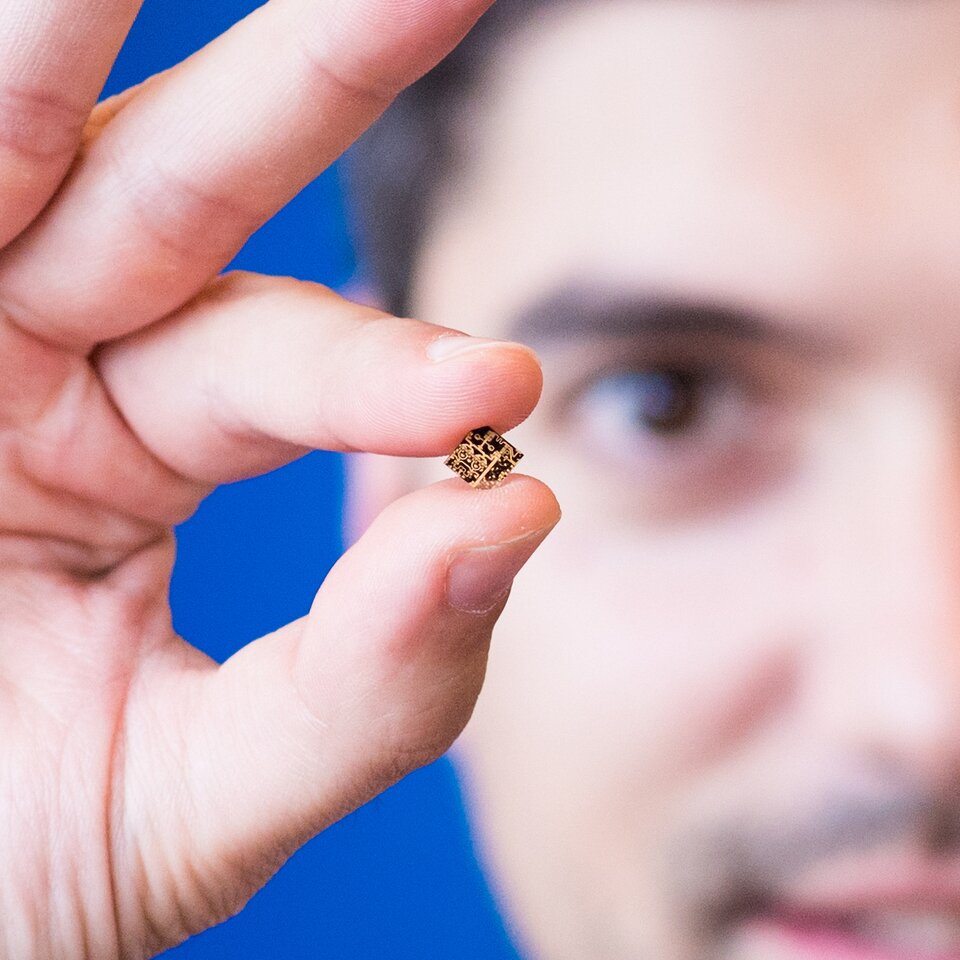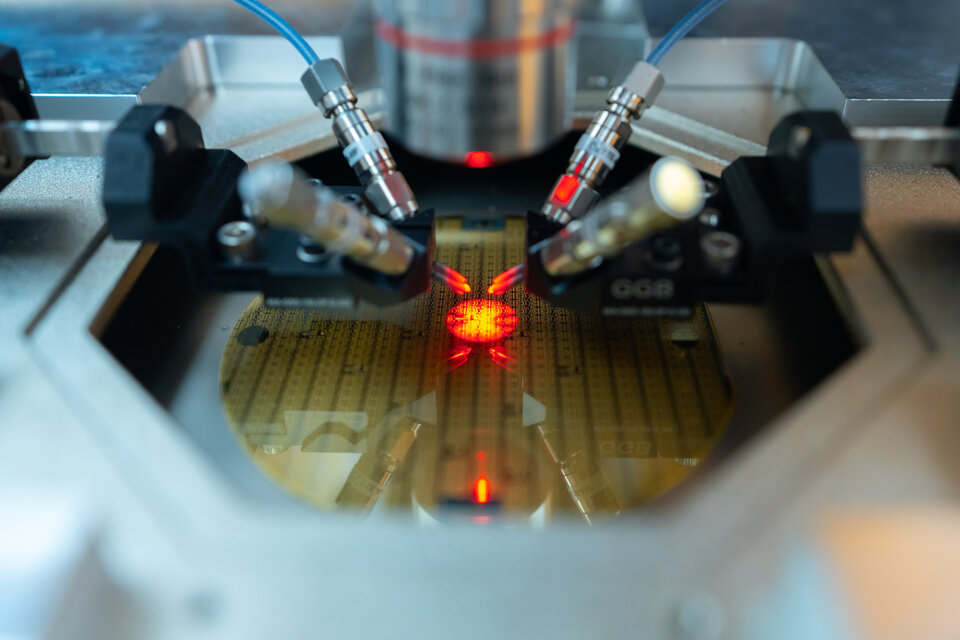R&D Successes Onboard Biomass
For any space mission to launch, thousands of hours must have been spent iterating new technologies to make the spacecraft fly. The Biomass satellite, which today shared its first science data, is no exception. The probe, which carries just a single instrument on board, will perform a five-year census of all the trees on Earth to teach us more about how climate change and pests are affecting the world’s forests than we’ve ever learnt before.
It will do this using a new type of P-band synthetic aperture radar. This will be the first time a P-band radar has been launched into space. But while this radar is the standalone instrument onboard, the spacecraft hosts a myriad of R&D projects developed at ESA over the years. From kick-starting tens of activities investigating new antennas, to the camera being used onboard, Biomass has been a driving force behind several ground-breaking developments from the Agency’s Technology Programmes.
The launch of the Biomass satellite marks a significant milestone in the exploration of Earth’s forests, combining innovative technologies and groundbreaking research from the European Space Agency (ESA). As a mission that aims to conduct the first-ever global forest census, Biomass is set to gather unparalleled data on carbon storage, forest health, and the broader effects of climate change. Behind this remarkable endeavour lies a legacy of technological innovation and cross-programme synergy that is shaping the future of space exploration.
Antenna Precision and Performance

One of the standout features of the Biomass mission is the spacecraft's deployment of a massive 12-meter diameter reflector antenna. This technology, to harness the long-wavelength ‘P-band’ radar signals, enables the precise communication and data transmission that makes the mission’s science so vital.
One of ESA’s Basic Activities, the Technology Development Element, has been working with Large Space Structures, Germany, to develop Europe’s first mesh reflector for shaped radio beams. ESA’s AMPER (Advanced techniques for mesh reflector with improved radiation pattern performance) project will optimise satellite-based communications and observations as the surface can be shaped to improve performance, filling a technological gap for Europe first identified in the early stages of the Biomass mission.
“When we looked into high priority candidate missions, ultimately all of the six missions implemented in the frame of Copernicus required a large deployable reflector antenna. So when we started to study these missions in Phase A, we needed an engineering model for a deployable antenna for Europe,” explains Martin Suess, the ESA engineer in charge of the antenna project.
The development of the deployable reflector was not without its challenges. Engineers needed to ensure the antenna would unfold correctly in space while withstanding extreme environmental factors. The solution came in the form of a gold-plated metallic mesh, just 20 microns thick, that forms the reflective surface.
“There are a number of TDE activities which precursor this one, now we have demonstrated the mechanical performance, we’ve tested performance under environmental conditions, we’ve put the folded reflector on shaker, then deployed it, did the same in the vacuum etc. It’s really almost ready for launch already,” says Suess.
The success of the technology push initiated by Biomass's need for an unfurlable antenna system has led to the European Large Deployable Reflector study, which has taken several developments from AMPER and other TDE activities to develop a large deployable antenna that will now be used onboard the Copernicus Imaging Microwave Radiometer (CIMR) mission, planned for launch in 2029.

The knowledge gained from these antenna developments is now being used for different kinds of missions, including CubeSats, which have too small a power supply on board to be able to deploy large antennas.
“Recent CubeSats missions are targeting lunar, asteroid and deep space,” Suess continues. “In all of those situations a significant antenna gain is needed and while solutions exist, deployable reflectarrays are ideal candidates to realise large deployable aperture antennas on CubeSats.”
To limit the risks inherent in developing deployable, complicated satellites, the General Support Technology Programme (GSTP) is continuing many of the projects first begun under TDE as a result of the lack of a European antenna for Biomass, and developing them for CubeSats instead.
One aims to design Ka band deployable reflectarray antennas with an aperture of one metre square and another (GT17-110EF) focuses on X-band.
By combining expertise from industry and academic partners as well as several Member States' own space agencies, ESA has overcome many of the key technical barriers it faced when it first tried to procure a deployable antenna for Biomass - resulting in a deployable antenna that is now being used to improve satellite-based communications and Earth Observation.
Miniaturised Cameras
Alongside the radar, Biomass also carries a state-of-the-art camera system developed through ESA’s GSTP. The MCAMv3 camera is designed to provide high-resolution images of Earth’s surface, plays a crucial role in monitoring forest health, tracking carbon sequestration, and assessing the impact of climate change. What makes this camera stand out is its ability to capture detailed images even under challenging conditions, contributing vital data that will help scientists understand the complexities of forest ecosystems.
The main objective of this project, co-funded through GSTP’s Element 2, was to realise an Engineering Model (EM) for a new generation of miniaturised cameras (the MCAM version 3) based on the concept owned by Micro-Camera and Space Exploration SA. Previous generations of the camera had already been proven in several space applications.
“The camera’s miniaturised, low-power design makes it a promising technology for use on smaller satellites, while its modularity allows customisation that meets the unique needs of various missions,” describes Eleni Adamou, ESA Technology R&D Engineer working on the activity. “It’s a cost-effective solution with very low mass and volume so it can be quickly integrated into missions that need images like this.”
The modular, miniaturised design of the MCAMv3 was chosen as it is adaptable for use in a wide range of missions but rugged enough that it can withstand the harsh conditions of space.
The successful co-funding of this advanced camera will make future Earth Observation missions, where high-resolution imagery is critical for monitoring environmental change, possible.
Powering the Future with Gallium Nitride

One of the most exciting innovations onboard Biomass is the use of Gallium Nitride (GaN) technology. GaN is a semiconductor material that offers significant advantages over traditional silicon-based components, including higher power efficiency, faster processing speeds, and better resistance to radiation—critical factors for space missions. The Biomass mission benefits from GaN’s ability to handle high voltages and temperatures, ensuring more reliable power electronics and communication systems onboard.

Through the GaN Reliability Enhancement and Technology Transfer Initiative (GREAT2), ESA has worked with a consortium of research institutes, design companies, and manufacturers to develop space-quality GaN components. These components are now used in the solid-state power amplifiers for Biomass’s radar system, replacing bulky and less efficient travelling wave tubes. Without GaN technology, the mission’s innovative radar system would not be feasible in its current form.
This technology is already revolutionising satellite communication systems, enabling faster data transmission and greater mission flexibility. It will be used for the second generation of the Galileo satellites and other upcoming Earth Observation missions.
The technologies developed because of Biomass will have lasting implications, not only for forest monitoring but for space exploration overall. The integration of GaN technology and advanced imaging systems will serve as a model for future missions, driving the development of more efficient, powerful, and sustainable space systems. While the developments made in antenna technologies have paved the way for a strong European industry in the field that didn’t previously exist. In the long run, the innovations demonstrated by Biomass will ensure Europe remains at the forefront of space exploration.


